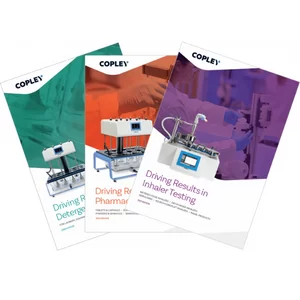Exploring the intricacies of mechanical calibration reveals a lot about dissolution tester design and performance. Join us to learn more…

Copley Enhanced Mechanical Calibration Kit
Dissolution testers are core analytical kit for oral solid dosage products, for the assessment of in vivo drug release profiles. The picture above is of the Copley Enhanced Mechanical Calibration Kit, a collection of instruments for mechanically calibrating them. If you want to learn more about doing that, in-house, read on.
But what if you have no intention of tackling calibration in-house?
Well, calling in the experts for routine calibration is a sound choice because of the complexity of the process. But in that complexity lies interesting lessons about what makes a dissolution tester work accurately. By knowing the calibration kit a little better we can gain insights that enhance our understanding of the dissolution testing process.
Regulations and requirements
Ensuring that a dissolution tester is fit-for-purpose, throughout its life, begins with installation qualification (IQ) and operational qualification (OQ). Mechanical calibration is useful from the outset. By confirming that multiple variables that affect dissolution measurements are within specification it helps to ensure that the tester is ready for use.
Following on from IQ and OQ, performance verification testing (PTV) with a reference standard tablet is standard practice for performance qualification (PQ). USP Chapter <711> now indicates use of the new USP Dissolution Performance Verification Standard (DPVS) for this purpose. On an ongoing basis assessing dissolution tester suitability typically then involves both rigorous mechanical calibration and PVT.
At first glance PVT appears the simpler proposition so it’s reasonable to question the necessity of this tandem approach. PVT assesses the ability of the tester to produce consistent data, when tested with a well-characterised, prednisone tablet. However, concerns over sensitivity and intra-lot tablet variability, mitigate against over-reliance on the results. The new DPVS marks a step forward in this regard but without complementary mechanical calibration data results may still provide insufficient insight for effective troubleshooting.
These issues provide a rationale for compendial specifications indicating the combined use of PVT and mechanical calibrationii. Enhanced mechanical calibration methods are the result of growing recognition of the relative value of mechanical strategies and routinely referenced. The relevant ASTM standard and FDA guidance both provide valuable detail about these methods. So too do USP recommendations , complementing the information in USP Chapter <711>. Our Enhanced Mechanical Calibration kit includes all the tools needed to implement the methods these documents describe.
A point to note is that none of the available guidance specifies a frequency for assessing dissolution tester performance. Rather the user is left to justify frequency on the basis of factors such as the degree of use and application. An understanding of the potential for performance drift supports such efforts.
Exploring the enhanced mechanical calibration kit
Examination of the items of the dissolution apparatus calibration kit highlights critical dimensions and characteristics of a dissolution tester that may change with time. Alongside a couple of items for OQ only (digital stopwatch and immersion probe), the kit includes:
- Digital Callipers: for measuring critical dimensions of the vessel, the paddle and/or the basket
- Digital Tachometer: for checking the accuracy of rotational speed of the paddle/basket shaft (+/-1 RPM at 50 and 100 RPM)
- Centricity Gauge: for assessing the centricity of the shaft within the vessel (radial deviation less than 1mm)
- Indicator holding arm with base and lever type dial gauge with extended stylus: for performing ‘wobble’ checks, for basket or paddle
- Digital Thermometer: for media tempering, to confirm the temperature of the media in all vessels of the dissolution tester relative to target value (+/-0.5oC)
- Digital Protractor: for assessing the verticality, horizontality and perpendicularity of various components. Examples include basket mesh to the plane of the top and bottom rings (perpendicular to within 1o); benchtop horizontality (to within 1o); agitator shaft verticality (to within 0.5o)
- Calibration Sphere (25mm, nylon): for setting paddle and basket height (to within +/-2mm)
Note: We’ve provided some indicative values of tolerances/specifications but please refer to specific guidance for details.
The impact of change
A first thought when looking through this list is that there are a lot of checks to make. A second may be why is the mechanical calibration process so involved.
In a dissolution test, two key factors influence the results, other than the properties of the product/test sample.
The first is temperature. This is why well-designed dissolution testers have integral, precise temperature control and measurement. Single point electronic temperature calibration is also worth watching out for, for easy routine checking. The goal is to be close to set temperature in every vessel (+/-0.5oC), with the USP also specifying a range (+/-0.4oC) across the tester. This safeguards vessel to vessel consistency.
The second is the mixing regime or hydrodynamics that prevail. Ensuring consistency in this respect is far more challenging because of the number of influential factors. Indeed, almost all the checks listed above, other than temperature, relate to this issue. Changes in the dimensions and geometry of the basket or paddle, for instance, or centring and speed of rotation of the shaft. Likewise, ‘wobble’ in any of the rotational elements, and in fundamentals such as the ability of the bench to maintain horizontality. By changing the subtleties of tablet – dissolution media contact such variables can shift the dissolution profile.
This sensitivity underlines the importance of care and maintenance, for any dissolution tester. Dropped, scratched or otherwise damaged components can easily disrupt the balance and symmetry of the unit. A prime example is the slight bending of agitator shafts, one of the most common issues we see when calibrating. Such sensitivity also emphasises the importance of investing in a robust, well-engineered unit, in the first instance, to optimise long-term performance.
In summary
The defining benefit of dissolution testing is its relevance. Dissolution testing rolls up many potential sources of variability in a result that reflects a key aspect of drug delivery, in vivo.
Similarly, dissolution testing can be susceptible to variability from multiple sources. Precision engineering, careful handling and effective fault detection are all crucial when it comes to keeping dissolutions testers fit-for-purpose. As is calibration. Take a closer look at our dissolution tester for more details.
iUSP-NF Notice of intent to revise. <711> Dissolution. May 2022. Available to view at: https://www.uspnf.com/notices/711-dissolution-nitr-20220527
iiUSP-NF 2024, Issue 1 Chapter<711> Dissolution
iiiAmerican Society for Testing and Materials (ASTM) Standard E 2503-13 ‘Standard Practice for Qualification of Basket and Paddle Dissolution Apparatus’ (Aug 2023)
ivFDA Guidance for Industry ‘The use of Mechanical Calibration of Dissolution Apparatus 1 and 2 – Current Good Manufacturing Practice’ (CGMP) (Jan 2010)
VToolkit Dissolution Procedure: Mechanical Calibration and Performance Verification Test








